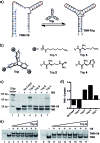Triptycene-based small molecules modulate (CAG)·(CTG) repeat junctions
- PMID: 26366282
- PMCID: PMC4538686
- DOI: 10.1039/c5sc01595b
Triptycene-based small molecules modulate (CAG)·(CTG) repeat junctions
Abstract
Nucleic acid three-way junctions (3WJs) play key roles in biological processes such as nucleic acid replication in addition to being implicated as dynamic transient intermediates in trinucleotide repeat sequences. Structural modulation of specific nucleic acid junctions could allow for control of biological processes and disease states at the nucleic acid level. Trinucleotide repeat expansions are associated with several neurodegenerative diseases where dynamic slippage is thought to occur during replication, forming transient 3WJ intermediates with the complementary strand. Here, we report triptycene-based molecules that bind to a d(CAG)·(CTG) repeat using a gel shift assay, fluorescence-quenching and circular dichroism.
Figures




Similar articles
-
Conformational and migrational dynamics of slipped-strand DNA three-way junctions containing trinucleotide repeats.Nat Commun. 2021 Jan 8;12(1):204. doi: 10.1038/s41467-020-20426-3. Nat Commun. 2021. PMID: 33420051 Free PMC article.
-
A single CAA interrupt in a DNA three-way junction containing a CAG repeat hairpin results in parity-dependent trapping.Nucleic Acids Res. 2024 Aug 27;52(15):9317-9327. doi: 10.1093/nar/gkae644. Nucleic Acids Res. 2024. PMID: 39041420 Free PMC article.
-
Slipped-strand DNAs formed by long (CAG)*(CTG) repeats: slipped-out repeats and slip-out junctions.Nucleic Acids Res. 2002 Oct 15;30(20):4534-47. doi: 10.1093/nar/gkf572. Nucleic Acids Res. 2002. PMID: 12384601 Free PMC article.
-
Molecular mechanisms of TRS instability.Adv Exp Med Biol. 2002;516:1-25. doi: 10.1007/978-1-4615-0117-6_1. Adv Exp Med Biol. 2002. PMID: 12611433 Review.
-
Trinucleotide repeat DNA structures: dynamic mutations from dynamic DNA.Curr Opin Struct Biol. 1998 Jun;8(3):321-30. doi: 10.1016/s0959-440x(98)80065-1. Curr Opin Struct Biol. 1998. PMID: 9666328 Review.
Cited by
-
Hierarchical coassembly of DNA-triptycene hybrid molecular building blocks and zinc protoporphyrin IX.Beilstein J Nanotechnol. 2016 May 12;7:697-707. doi: 10.3762/bjnano.7.62. eCollection 2016. Beilstein J Nanotechnol. 2016. PMID: 27335759 Free PMC article.
-
Bridgehead-Substituted Triptycenes for Discovery of Nucleic Acid Junction Binders.Org Lett. 2016 May 20;18(10):2423-6. doi: 10.1021/acs.orglett.6b00945. Epub 2016 May 12. Org Lett. 2016. PMID: 27172288 Free PMC article.
-
Modulation of the E. coli rpoH Temperature Sensor with Triptycene-Based Small Molecules.Angew Chem Int Ed Engl. 2016 Jul 11;55(29):8258-61. doi: 10.1002/anie.201601626. Epub 2016 May 30. Angew Chem Int Ed Engl. 2016. PMID: 27240201 Free PMC article.
-
Interactions of small molecules with DNA junctions.Nucleic Acids Res. 2022 Dec 9;50(22):12636-12656. doi: 10.1093/nar/gkac1043. Nucleic Acids Res. 2022. PMID: 36382400 Free PMC article. Review.
-
Post-translational protein lactylation modification in health and diseases: a double-edged sword.J Transl Med. 2024 Jan 10;22(1):41. doi: 10.1186/s12967-023-04842-9. J Transl Med. 2024. PMID: 38200523 Free PMC article. Review.
References
-
- Howell L. A., Searcey M. Chembiochem. 2009;10:2139–2143. - PubMed
- Sharma A. K., Heemstra J. M. J. Am. Chem. Soc. 2011;133:12426–12429. - PubMed
- Zhang H., Endrizzi J. A., Shu Y., Haque F., Sauter C., Shlyakhtenko L. S., Lyubchenko Y., Guo P., Chi Y. RNAi. 2013;19:1226–1237. - PMC - PubMed
- Teo Y. N., Kool E. T. Chem. Rev. 2012;112:4221–4245. - PMC - PubMed
- Wang F., Lu C. H., Willner I. Chem. Rev. 2014;114:2881–2941. - PubMed
- Stojanovic M. N., de Prada P., Landry D. W. J. Am. Chem. Soc. 2000;122:11547–11548. - PubMed
- Benvin A. L., Creeger Y., Fisher G. W., Ballou B., Waggoner A. S., Armitage B. A. J. Am. Chem. Soc. 2007;129:2025–2034. - PMC - PubMed
- Kellenberger C. A., Wilson S. C., Sales-Lee J., Hammond M. C. J. Am. Chem. Soc. 2013;135:4906–4909. - PMC - PubMed
- Porchetta A., Vallee-Belisle A., Plaxco K. W., Ricci F. J. Am. Chem. Soc. 2012;134:20601–20604. - PMC - PubMed
-
- Leonard C. J., Berns K. I. Prog. Nucleic Acid Res. Mol. Biol. 1994;48:29–52. - PubMed
- Watts J. M., Dang K. K., Gorelick R. J., Leonard C. W., Bess Jr J. W., Swanstrom R., Burch C. L., Weeks K. M. Nature. 2009;460:711–716. - PMC - PubMed
- Bai Y., Tambe A., Zhou K., Doudna J. A. eLife. 2014;3:e03656. - PMC - PubMed
- Guo P. Nat. Nanotechnol. 2010;5:833–842. - PMC - PubMed
- Shu D., Shu Y., Haque F., Abdelmawla S., Guo P. Nat. Nanotechnol. 2011;6:658–667. - PMC - PubMed
- Tian L., Weizmann Y. J. Am. Chem. Soc. 2013;135:1661–1664. - PubMed
- Endo M., Sugiyama H. ChemBioChem. 2009;10:2420–2443. - PubMed
-
- Mirkin S. M. Nature. 2007;447:932–940. - PubMed
- Liu G., Chen X., Bissler J. J., Sinden R. R., Leffak M. Nat. Chem. Biol. 2010;6:652–659. - PMC - PubMed
- Slean M. M., Reddy K., Wu B., Nichol Edamura K., Kekis M., Nelissen F. H., Aspers R. L., Tessari M., Scharer O. D., Wijmenga S. S., Pearson C. E. Biochemistry. 2013;52:773–785. - PMC - PubMed
-
- Chenoweth D. M., Harki D. A., Dervan P. B. Org. Lett. 2009;11:3590–3593. - PMC - PubMed
- Rarig R. A. F., Tran M. N., Chenoweth D. M. J. Am. Chem. Soc. 2013;135:9213–9219. - PubMed
- Dervan P. B. Bioorg. Med. Chem. 2001;9:2215–2235. - PubMed
- Chenoweth D. M., Meier J. L., Dervan P. B. Angew. Chem., Int. Ed. 2013;52:415–418. - PMC - PubMed
- Chenoweth D. M., Dervan P. B. J. Am. Chem. Soc. 2010;132:14521–14529. - PMC - PubMed
- Chenoweth D. M., Dervan P. B. Proc. Natl. Acad. Sci. U. S. A. 2009;106:13175–13179. - PMC - PubMed
- Hirata A., Nokihara K., Kawamoto Y., Bando T., Sasaki A., Ide S., Maeshima K., Kasama T., Sugiyama H. J. Am. Chem. Soc. 2014;136:11546–11554. - PubMed
- Asamitsu S., Kawamoto Y., Hashiya F., Hashiya K., Yamamoto M., Kizaki S., Bando T., Sugiyama H. Bioorg. Med. Chem. 2014;22:4646–4657. - PubMed
- Chenoweth D. M., Poposki J. A., Marques M. A., Dervan P. B. Bioorg. Med. Chem. 2007;15:759–770. - PMC - PubMed
Grants and funding
LinkOut - more resources
Full Text Sources
Other Literature Sources

